Intel X58 Motherboard Roundup - What does $300 Get You?
by Gary Key on December 5, 2008 3:00 PM EST- Posted in
- Motherboards
Gigabyte GA-EX58-UD5
Features
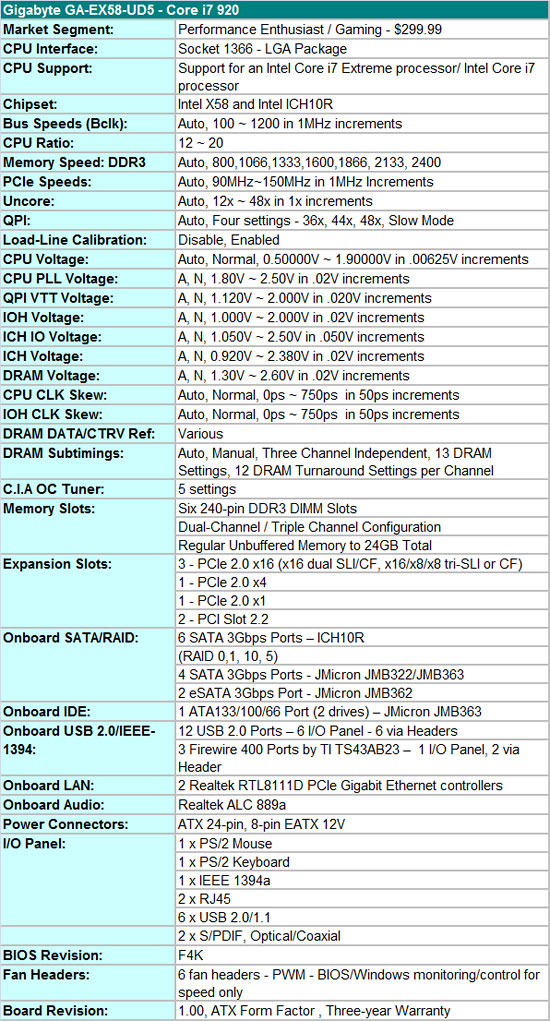
We have to hand it to Gigabyte; if there was an empty spot on the board during the design phase, they figured out a way to add a feature in that space. This board is loaded with everything but the kitchen sink and yet it appears mostly uncluttered; only when using the board do you sometimes notice that it is crowded. Gigabyte throws in twin Realtek RTL-8111D PCIe Gigabit Ethernet controllers that can be teamed; the Realtek ALC-889a is on board for HD audio and features real-time Dolby Digital Live encoding; JMicron’s JMB322/363 chipsets are tabbed for IDE and additional SATA port duties; TI is selected for IEEE 1394a; and the Intel ICH10R is onboard for primary storage purposes.
The BIOS is designed for those who like to tweak for a living. For some, the number of available options will be overwhelming while others will take joy in squeezing out every last little bit the board has to offer. The number of memory timing options is immense and includes the ability to setting timings for each individual channel. However, as we also found with the ASUS board, the auto settings are not always spot on.
Also, the latest beta BIOS we utilized (F4H) has a habit of overriding manual memory settings. This can be a good and bad decision on behalf of the BIOS. The good is that it will do its best to keep the user out of trouble; the bad is that when we manually tweak a board we would like to know when we are in trouble. In the end, the settings determined by the BIOS were always stable and performance was generally not detrimental. We will look at this as a glass half full situation. (update - BIOS F4K received today corrects this problem)
The only nitpick we truly have with the BIOS centers on Load-Line calibration. The purpose of this setting is to reduce VDroop and it works perfectly on the other boards. On our particular board sample we still noticed VDroop when a VCore setting of 1.425V resulted in 1.392V real. Gigabyte is aware of this and is working on it now. Otherwise, we commend Gigabyte for a well laid out BIOS and for offering the enthusiast just about every option one could use on a board.
Gigabyte supports a stock 800MHz ~ 2400MHz memory speed on the i920/i940 processors along with opening up QPI link speeds from a standard 4.800 GT/s up to 6.400 GT/s. They also include a slow mode QPI link speed for high Bclk testing. The board supports up to 24GB of DDR3 memory. We have not had any problems running 12GB of our Patriot or G.Skill DDR3-1600 kits with the latest F4H BIOS. Our final settings are at 1600 with 9-9-9-24 1T timings at 1.66V. Although the timings are looser than the other boards, performance is basically equal; only a user looking for that last bit of advantage in a benchmark would notice a difference.
The three PCI Express 2.0 x16 slots will operate in x16/x16 mode for 2x SLI/CF if the third x16 slot is empty. If you decide to place a PCIe RAID, network, audio, or TV tuner card in the third x16 slot, then the 2x SLI/CF configuration will operate in x16/x8 mode. 3x SLI/CF configurations will run in x16/x8/x8 mode. We had no problems running our ASUS Xonar D2X or Highpoint Rocket RAID cards in x16 slots two or three.
The Board
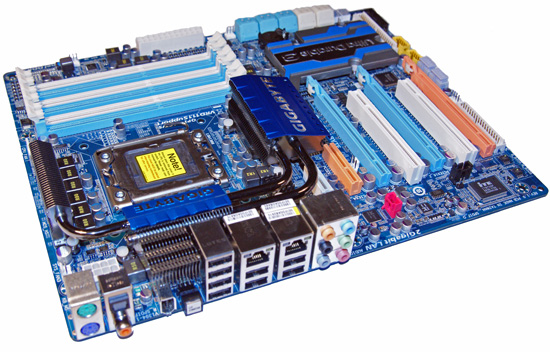
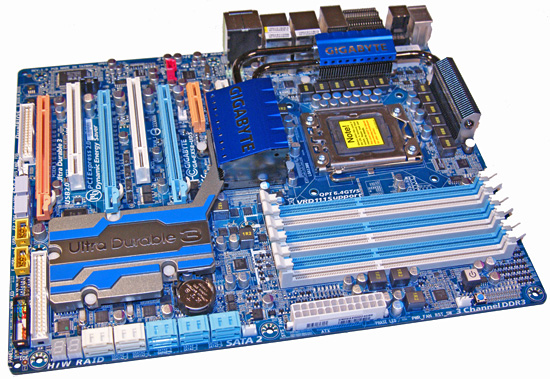
The $299 GA-EX58-UD5 is Gigabyte's mid-range X58 board, with the Extreme version being at the top end with a $330 price tag and the DS4 board placed at the low end with a $245 street price. We think Gigabyte's product separation is right on considering the feature set on each board, although we had hoped the DS4 would also have SLI capability considering the additional cost when compared to the MSI Platinum board.
Gigabyte introduced a new color palette on this board and we like it for the most part. We still notice a few of the crayola colors in use but overall this board would not look bad in a case with a large window. The one item that stands out on the board is the rather large heatsink for the ICH10R/JMicron controllers proudly displaying the Ultra Durable 3 technology incorporated on the board. Ultra Durable 3 refers to Gigabyte's use of solid-state Japanese capacitors, ferrite core chokes, and low RDS(on) MOSFETs along with an extra dose of copper in the board layers.
All of this is meant to improve overclocking potential and extend the life of the board. Until we get to our sub-zero overclocking article, it has been difficult to notice any overclocking differences between this board and the others in our roundup. However, we do appreciate the high quality components that Gigabyte included at this price point.
Gigabyte provides a hefty combination of heatsinks for the northbridge and vrm areas that link together with a heatpipe system. In fact, part of the first VRM heatsink extends into the IO panel to provide an exhaust outlet for the cooling system. Of course this system relies on radial type cooling for proper heat dispersion. We highly recommend direct air-cooling in this area if you are utilizing a tower heatsink/fan for the CPU or water-cooling when overclocking.
The CPU area is fairly open and our larger air coolers installed perfectly without interference from the heatsinks. However, a large air cooler like the Monsoon Vigor III that we utilized will render the first DIMM socket unusable, essentially limiting you to only populating three of the DIMM slots. This board features a two-phase power delivery system for the northbridge and a two-phase delivery for the memory subsystem. A twelve-phase power delivery design is utilized for the processor, which could be construed as overkill, but it does serve its purpose when overclocking. Like the other boards, the capacitors in the CPU area are fairly close to the 1366 socket, something that is important to note when utilizing other cooling methods like large water blocks, cascade, or LN2 setups.
The general layout is very good considering the vast number of ports, slots, and hardware included on the board. Gigabyte's design keeps interference to a minimum with installed peripherals for the most part. The board includes three PCI Express 2.0 x16 slots (x16/x8/x8), one PCIe x1 slot, a single x4 slot, and two PCI slots. This arrangement allows 3X Crossfire or SLI and still leaves the PCIe x1 and x4 slots open. However, using double slot cards for CF or SLI will render the PCI slots physically unusable. It is at this point that we realized a couple of potential problems with this layout.
The first PCIe x1 slot can only be utilized with a half length card, which excludes most audio and tuner cards. The bigger problem is that when utilizing two double slot cards for CF or SLI, the cards sit right next to each other, which inhibits airflow. The same holds true when utilizing the third x16 slot. When installing a dual-slot card in the third slot, it will hangover the board, which could create an installation problem in most cases. We do not care for 3X CF/SLI for general gaming, so we would have preferred a proper dual x16 design or an additional slot between the first two x16 slots to improve cooling or allow water-cooling on the GPUs.
At the rear of the board are the ten SATA ports, a Debug LED display unit, and the IDE connector. The gigantic heatsink covers the ICH10R and the JMB 363/322 controller chipsets. The JMB322s are responsible for the two white SATA ports and offer driver-free RAID 0 and 1 support. The hardware stack in the JMB322 makes arrays appear as standard hard drives and hence the lack of required software drivers when setting them up. Gigabyte took a different approach and hooked the JMB322s directly into JMB363 SATA ports instead of riding on the PCI Express bus as they do on the MSI board. This results in slightly lower performance as our PCMark Vantage HDD test suite will indicate later on. All ten SATA ports have a right angle cable connection scheme that allows them to be utilized even with the longer double-slot video cards. About the only drawback is placing this board in a smaller case where the drive bays would butt up against the board. Even so, we feel this arrangement is the right way to go.
In a change from other board designs, Gigabyte locates the power on and reset buttons behind the DIMM slots, an unusual location but one that we grew accustomed to quickly. At the front of the board Gigabyte places their dual BIOS chips, which can come in handy in case a flash attempt goes south. Also, they figured out a way to include a floppy connector, although we no longer care to see them on boards in this market sector. Gigabyte also throws in some onboard LEDs to light up your life. Actually, they do serve a purpose besides looking cool in a windowed case at night: the LEDs will let you know how many phases are being utilized by the board during operation.
The IO panel features eight USB 2.0 ports, two Ethernet jacks with LED indicators, an IEEE 1394a port, standard PS/2 keyboard/mouse ports, coaxial and optical S/PDIF output ports, and a handy clear CMOS button. The audio panel offers connections to the Realtek ALC 889a HD audio codec. The one thing missing on this board is a fixed eSATA port. However, Gigabyte includes an expansion slot backplate that allows an additional two external SATA ports via any of the board's internal SATA connections.
The Applications
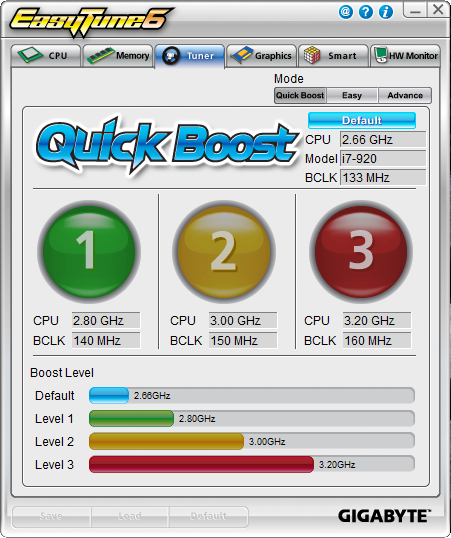
Gigabyte provides their EasyTune 6 application that provides monitoring, system information, and overclocking capabilities. This is one of the best applications provided by the various motherboard suppliers for tuning the system within Windows. We would still like to see the ability to save the settings to the BIOS or at least a BIOS profile; otherwise, this application is useful for extracting a fair amount of performance improvement out of the system within Windows.
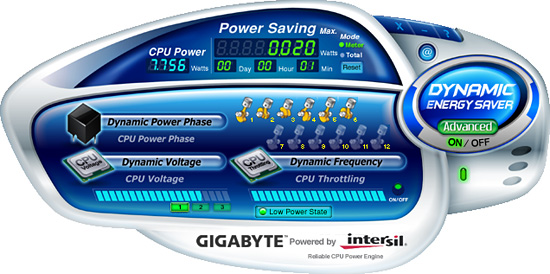
Gigabyte recently updated their DES (Dynamic Energy Saver) software so it is compatible with the X58 chipset, along with providing BIOS improvements. Our original F2 BIOS would not work properly with the latest DES beta but the F4 series has made great strides in this department. We noticed a 5W improvement in idle rates and a 1W improvement in our load tests with DES. Gigabyte expects some additional savings once the software and BIOS are finalized. The DES system offered fast switching times once a full load was placed on the system and we did not experience any crashes during our benchmark tests.






















78 Comments
View All Comments
TeXWiller - Friday, December 5, 2008 - link
Are you sure the 6 DIMM configuration is even supported with the current Nehalem at DDR3-1333 speed? Supermicro X8SAX, for example, does not support 6 DIMM configuration over DDR3-1066 speed, which is also the maximum Intel supported speed. This might explain some of those POST related problems.javamann - Friday, December 5, 2008 - link
I usually go for the high end board but I don't overclock. I expect if a board is built to run at a higher speed running at a normal speed would sit in the middle of the bell curve of it operating parameters. I would also expect it to just work. My bad.mjz - Friday, December 5, 2008 - link
not having support for 24GB ram of the bat is ridiculous.. With DDR3 ram going to be at a decent price next year, why not??? having 15GB as a ram disk would be amazing for many people.. this is MB companies being lasyAeroWB - Friday, December 5, 2008 - link
"Hey guys, Anand here. I'm writing this sub-section, not at Gary's request, but because I felt it was necessary."I totaly agree with you here, thanks for letting us know the size of the problem and Gary thanks for all those fixes.
"The point being is that we feel the lack of quality assurance before a product hits the market has now reached an all time high."
I do believe this is true, and I also have to say that I'm having problems with these kind of things for quite some years now, and I'm getting sick and tired of this.
For me the crap kickstarted in 2001 with an MSI mainboard, one brand I will never buy again...
(2001) MSI K7N420 Pro, it took MSI half a year to fix the issue of not being able to run the ram in dual channel mode on default speed without data corruption (the year I learned about memtest86) Also this board could not boot from an LSI 21320-R SCSI card and that problem has never been fixed (the Asus board with the same chipset could do it but my attempt to put that bioscode in the MSI bios failed)
(2003) Asus A7N8X-E Deluxe. onboard Marvell Gigabit card corrupted data, about one bit each 2GB so all my DVD downloads were corrupt! at 100Mbit it worked ok, an add-on Gb card also worked ok, lots of bios updates, no solution. Here's probably too much controllers cramped in not enough space. After 3 years upgrading the ram to 2GB didn't work, tried a lot of different brands. Bought an Intel D975XBX. (but the asus did support my LSI SCSI card!)
(2005) SuperMicro PDSGE, I finally bought a board with PCI-X for my Netware Server with SmartArray controller (which before was running in an Intel D945GTP desktopboard on PCI). The SmartArray card would boot, I got 2 special biosses for the board from Supermicro (great supportteam) but could't get it to work so added extra disk to boot the system, problem never solved. but it seems strange the controller working on a desktopboard and not on a server board. Updating the SmartArray also didn't help, My server still runs this board but now has a never HP SmartArray 641 that does work.
(2008) Asus M3A78-T, Razer Lachesis mouse is not working when powering up, I have to reinsert the usb connector of it everytime I start the computer to get it working (standby doesn't help) In 4 months I have flashed 3 newer bios versions in the mainboard and 2 in the mouse. Problem still exists. The Lachesis works fine in my IntelD975XBX system. My Razer Copperhead works fine in both (so I swapped the mice)
All listed boards are only from my private systems, I work at a computershop for over 10 years so needless to say I saw much more bios/board misery.
So far I have had the least problems with Intel boards but they also have their share of problems. Some years ago the company switched from Asus to Intel partially because alot of customers sometimes accidently overclocked their system (the boards got into the bios if they thought the post failed) and it got unstable. I really do not get why there are so many overclocker options while 90% of the people doesn't use it and just want a stable system. If for example I now look at Asus' website I almost get a heart attack, there are just too many mainboard models, most are not interesting at all, too many useless onboard crap, too expensive, absurd features (Aopen tube board for example), crap quality chipsets, etc. And in all that mess there's no board without overclocking and quality components except maybe some Intel models. Try to find a board that will get your vidcard and soundcard a real free non-shared interrupt, you can't. So there is too many stuff and not enough simple quality models. How can they test and support all those models, well they can't as we know now. They don't update drivers for their chipsets and onboard junk, so you have to search yourself. It looks like they haven't got enough time to do it good so why not make less models and get it working right. All of this holds true for many brands not only Asus. Maybe the economic crysis will have a positive side-effect of getting less different models but better supported and tested components.
Only pointing the finger at the manufacturers however is too easy.
Lots of review-sites focus on speed and overclocking, exagerating speed differences, over-hyping all kind of not-so-usefull onboard junk. Its all speed and quantity for the least money, so boards come factory overclocked, memory timings set to tight, onboard controllers that almost no-one needs etc. Just so it looks they provide more bang for the buck then the competition and get a better review score.
Lots of customers want the most speed and features for the least money, and forget about quality, support etc. Manufacturers look at the market and provide the crap that people scream for to get bashed by those customers for the crap, that will still buy the cheapest stuff next time. so the demand for shit doesn't decrease so the shit is provided again....
chizow - Friday, December 5, 2008 - link
I've felt the motherboard industry has been the weakest link in the PC industry for a very long time. I'm really glad someone finally called them out on it.I used to get REALLY upset at AT reviews because they'd publish a review making it seem these boards are rock solid stable with insane overclocking ability only to learn the ugly truth once I got the board home. It wouldn't take long to confirm it with other reports of underwhelming performance totally out of line with various reviews.
BIOS stability and quality certainly needs to improve, especially if board makers want to charge such insane prices for something that has always seemed low-end and interchangeable. Its probably a good thing that the market for mobo makers has shrunk, now they can focus on quality and add some value by making these things last longer than 6-9 months.
haukionkannel - Friday, December 5, 2008 - link
When I bought last time purhaced new PC. It had vorce USB support that I can imagine. Every time I put an new USB devile like USB stick, the computer freeces down after short or long period of time... Ower the years situation got better and better. But It reguired a lot of installing of new versions of Bios... And yeh, it was expensive motherboard from big maker.I am allmost somewhat customed to that the computer does not properly... and that is something that is not right! It should work better from the beginning.
Maybe we need some form of ISO standard for new mother board:
When these and these things works. You can start selling these items and review sites starts makin revies of them. Prewievs and beta programs are different story all to gether, but final product shoulf be better.
Now we only need a forum where to make that standard. I am quite sure that testers are even more frustracted with stupid errors they encounter than I who has never been "huge" over clocker.
- - - - - -
1) The machine must works with all specified memory configurations
2) Informed normal speeds should work with all integrated parts
3) the machine should be stable enough to run 24 hours burn test with adverticed speed specifications.
4) If you allso overclock it 10-20% That is good extra, but I expect more of these after more mature bios.
This list is not accurate enough, but somekind od insurance is needed! I Thank you for your hard work. For normal user these test you make are the only way of getting to know who can still make desent bios and who can not!
karhill - Friday, December 5, 2008 - link
"Catering or focusing exclusively to the extreme overclocking community has resulted in initial product launches that are focused on getting the highest possible results from a product at the expense of usability, compatibility, and stability."EXACTLY. Board stability and features that work are SO MUCH MORE IMPORTANT to me than overclocking. When I buy a board, that's what I'm looking for: stablity and features that work. Any consideration of overclocking is simply as an indicator for the qualities that matter to me; that is, I figure if board overclocks well, then it ought to be extra stable at stock speeds.
TennesseeTony - Friday, December 5, 2008 - link
The ASUS P6T Deluxe sounds exactly like what you've been describing. Screw 12GB of RAM, I can't get six 1GB sticks of OCZ-1333 to boot/post. 3GB great. 4GB, fine, no problem. 5GB, yep, works just fine. But put that sixth stick of memory in there, in ANY of the slots, and when that little annoying blue led by the mem slot turns on, the computer dies.Vista won't boot on the SAS controller (64bit). ASUS says it's Microsoft's problem, nothing wrong with them... XP64 finally loaded up, I think I'm on Windows installation number 14, still buggy.
I've been quite pissed with Anandtech for not coming through with all the promises of overclocking guides and such, but thank you, Anand, for finally shedding some light on the problems behind the delays, and an extra big thank you for deciding to only give them two strikes, then they're out! It's far past time!
pwndcake - Friday, December 5, 2008 - link
So, the motherboard companies are using yours and other tech sites for free QA testing? Am I reading this right? Not a bad idea really. They don't even have to pay the price of 12GB of RAM to get all the testing and feedback they need.tmath2 - Sunday, October 4, 2009 - link
Hear Hear !!! Call it like you see it! The though had occured to me also that the mob mfr's could save a ton on salaries by out-sourcing the Quality and Assurance departments to AnandTech and other hardware review websites!